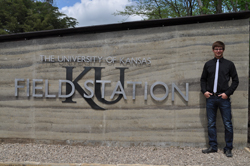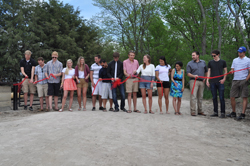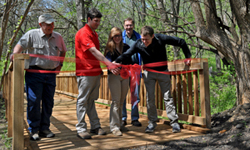KU Field Station adds two new structures designed and built by students
LAWRENCE — Two new infrastructure projects, a bridge and a gateway designed and built this spring by University of Kansas students, add to the visitor-friendly features at the KU Field Station north of Lawrence. The projects were built by students in architecture and architectural engineering classes. They are the most recent of many projects undertaken at the Field Station by KU students in the sciences, the humanities and the professional schools.
 “We appreciate the opportunity to provide this magnificent outdoor laboratory for students to gain experience designing and building structures as part of their educational experience,” said Ed Martinko, director of the Kansas Biological Survey. “We’re gratified to see the students’ excitement and contributions of their time and effort in their class projects.”
“We appreciate the opportunity to provide this magnificent outdoor laboratory for students to gain experience designing and building structures as part of their educational experience,” said Ed Martinko, director of the Kansas Biological Survey. “We’re gratified to see the students’ excitement and contributions of their time and effort in their class projects.”
The first of the two new projects is a 30-foot wooden bridge over a low point on the Roth Trail. It serves an aesthetic purpose and also makes it possible for small vehicles to cross so the Kansas Biological Survey, which manages the KU Field Station, can provide access to upper parts of the trail for maintenance and safety. Three KU senior architectural engineering students, working with Bob Lyon, professor of the practice in the Department of Civil, Environmental and Architectural Engineering, completed the bridge in early May. The students are Staci Ashcraft, Rogers, Ark.; Tyler Monnett, Overland Park, and Aaron Schneider, Lenexa. Most of the building materials for the project were donated by the Westar Green Team.
Three KU senior architectural engineering students, working with Bob Lyon, professor of the practice in the Department of Civil, Environmental and Architectural Engineering, completed the bridge in early May. The students are Staci Ashcraft, Rogers, Ark.; Tyler Monnett, Overland Park, and Aaron Schneider, Lenexa. Most of the building materials for the project were donated by the Westar Green Team.
“Discovering the Field Station has been a great stimulus to our senior design projects class,” Lyon said. “The willingness of the Kansas Biological Survey staff to partner with us and provide opportunities for student groups to improve and benefit the site is a wonderful resource for our department. The Field Station projects have given our students real-world experience in planning, design, construction and client relations—with the right amount of support, guidance, encouragement and creative freedom.”
 The bridge is in a wooded area of the Roth Trail, which is part of the Field Station’s five-mile public trail system. The trails lead visitors through forest, wetland and native prairie environments in the northern tracts of the Field Station, which total about 1,800 contiguous acres. Amenities on the trails include restrooms and drinking fountains, patio areas with picnic tables and interpretive signage. Trails are open to the public year-round, dawn to dusk.
The bridge is in a wooded area of the Roth Trail, which is part of the Field Station’s five-mile public trail system. The trails lead visitors through forest, wetland and native prairie environments in the northern tracts of the Field Station, which total about 1,800 contiguous acres. Amenities on the trails include restrooms and drinking fountains, patio areas with picnic tables and interpretive signage. Trails are open to the public year-round, dawn to dusk.
The second of the new projects is a gateway to the Field Station’s research and operations center and Armitage Education Center, 350 Wild Horse Road, Jefferson County. The gateway fulfills a key wayfinding function for visitors attending special events and for visiting researchers. Its construction of rammed earth, charred wood, metal and native stone visually integrates several trailhead structures built at different periods in the Field Station’s history.
Sixteen third-year students designed and built the structure as a class project, completing it in May. They used the technique known as rammed-earth construction, which involves mixing earth with a small amount of cement and water, then compacting it using pneumatic tools.
The gateway is the second rammed-earth structure built at the Field Station by students in the Architectural Design IV course—informally known as DirtWorks Studio — of Assistant Professor Chad Kraus. The first such structure there, the Stanley D. and Janet B. Roth Trailhead, built in 2012, won two awards from the American Institute of Architects.
The gateway is the fourth project commissioned by the Kansas Biological Survey at the Field Station through the KU School of Architecture, Design and Planning.
“We’re deeply appreciative of our mutually beneficial collaborations with the Kansas Biological Survey,” Kraus said. “They are courageous clients who support the hands-on experience that we, as educators, want to provide for our students—who have poured their passion, creativity and ingenuity into these works of architecture in the hope that they will have contributed something real and tangible to their community.”
Students in the class who designed and built the gateway are as follows: Damon Baltuska, Lenexa; Melody Benyamen, Cairo; Michael Burch, Emily Held and Scott Moran, St. Louis; Zac Dawson, Roscoe, Ill.; Ryan Falk, Onaga; Justin Gomez, St. Peters, Mo.; Maria Guerrero, Olathe; Benjamin Jensen, Leawood; Lindsey Jones, Lawrence; Jim McLarty, Eureka, Mo.; Lauren Reinhart, Parkville, Mo.; Kevin Staten, Kirkwood, Mo.; Scott Stoops, Ottawa; and Tu Tran, Kansas City, Mo.
The KU Field Station totals about 3,400 acres across 10 tracts in Douglas, Jefferson and Anderson counties. It is managed by the Kansas Biological Survey, which was established at KU in 1911.